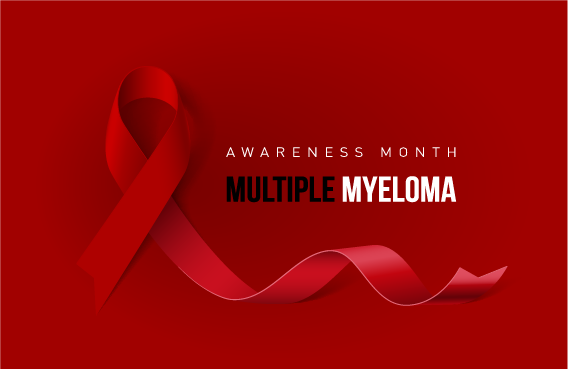Myeloma Action Month 2022
March is Myeloma Action Month. It is a month to bring people together to find ways to help people with myeloma. Myeloma is a cancer of plasma cells, which are cells found in the bone marrow. They are one of many important parts of the immune system. The immune system is made up of different infection fighting cells including lymphocytes, T cells, and B cells. B cells responding to an infection turn into plasma cells, which make the proteins called antibodies. These proteins help the body by attacking and killing pathogens. Plasma cells that become cancerous and grow out of control create abnormal antibodies called monoclonal immunoglobulin, monoclonal protein (M-protein), M-Spike, and paraprotein. The cancerous condition is called multiple myeloma. There are some conditions with abnormal plasma cells that are not considered multiple myeloma including monoclonal gammopathy of uncertain significance, smoldering multiple myeloma, solitary plasmacytoma, and light chain amyloidosis.
People with multiple myeloma can experience different symptoms. Myeloma can damage bone by either damaging the outer structure of the bone or secreting substances that inhibit bone repair and growth. Around 85 percent of people with multiple myeloma have some type of bone loss. People then experience bone pain and fractured bones. People can also have lower blood cell counts, leading to fatigue because oxygen is not getting to where it needs to be. People with multiple myeloma are also more likely to experience kidney failure or at least impaired kidney function because excess M protein inhibits the kidneys from filtering metabolic waste form the blood. Since multiple myeloma grows in the bone marrow, it inhibits the creation of blood cells, leading to anemia, impaired immune system function, and clotting issues.
Multiple treatments are available for multiple myeloma. Surgery is rarely used, but it can sometimes be used to remove single plasmacytomas. If the spinal cord compresses and someone experiences muscle weakness, numbness, or paralysis emergency surgery would be considered. Metal rods and plates could also be surgically added to support weakened bones. External beam radiation therapy is also a possibility, where high energy rays are administered to cancerous areas. It is also used to prevent paralysis when pressure is put on the spinal cord and spinal nerves. Doctors also use typical cancer treatments like chemotherapy to kill cancer cells. Corticosteroids are also useful to stop nausea and vomiting caused by chemotherapy. Another major treatment effective for myeloma is a stem cell transplant. High dose chemotherapy is first used to kill cells in the bone marrow and new healthy blood forming stem cells replace them. People are typically given drugs beforehand to kill as many myeloma cells in the body as possible. CAR T-cell therapy, which is used for other cancers, is also a useful treatment. Doctors remove T cells from the person’s body, which are then sent to a lab to be altered. The alteration creates specific receptors so the T cells can attach to cancer cells. They are then administered back to the body where they can help attack cancer cells.
If you would like to participate in Myeloma Action Month, first visit the International Myeloma Foundation. It has ways to get involved including a social media post creator to personalize posts intended for different social media channels. You can also use the proper hashtag #MYelomaACTION to spread the word about the illness. Learning about the symptoms of myeloma is also a great way to get more involved. If you know the symptoms, you can seek a doctor if you are experiencing them or recommend someone see a doctor if the person is experiencing them.
Multiple myeloma can be caused by benzene, an industrial chemical used by many different industries. It is a naturally occurring chemical found in forest fires and near volcanoes as well as crude oil, gasoline, and cigarette smoke. Benzene is used in many industries to create plastics, resins, nylon, synthetic fibers, lubricants, rubbers, dyes, detergents, drugs, and pesticides. If you have multiple myeloma and worked in any of the above industries, contact us today to see if you could be entitled to compensation. Use our contact form and a member of our team will get back to you as soon as possible or call us at 412-471-3980 to speak with someone immediately (during business hours). We will do whatever we can to help.




